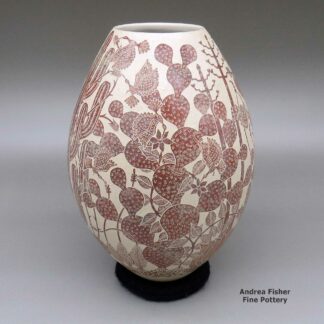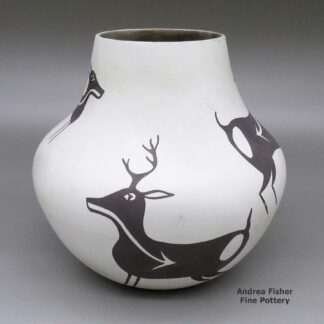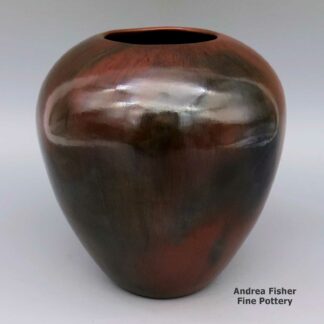Jar
About Jars
The jar is a basic utilitarian shape, a container generally for cooking food, storing grain or for carrying and storing water. The jar's outer surface is a canvas where potters have been expressing their religious visions and stories for centuries.
In Sinagua pueblos (in northern Arizona), the people made very large jars and buried them up to their openings in the floors of the hidden-most rooms in their pueblo. They kept those jars filled with water but also kept smaller jars of meat and other perishables inside those jars in the water. It's a form of refrigeration still in use among indigenous people around the world.
Where bowls tend to be low, wide and with large openings, jars tend to be more globular: taller, less wide and with smaller openings.
For a potter looking at decorating her piece, bowls are often decorated inside and out while most jars are decorated only on the outside. Jars have a natural continuity to their design surface where bowls have a natural break at the rim, effectively yielding two design surfaces on which separate or complimentary stories can be told.
Before the mid-1800s, storage jars tended to be quite large. Cooking jars and water jars varied in size depending on how many people they were designed to serve. Then came American traders with enameled metal cookware, ceramic dishes and metal eating utensils...Some pueblos embraced those traders immediately while others took several generations to let them and their innovations in. Either way, opening those doors led to the virtual collapse of utilitarian pottery-making in most pueblos by the early 1900s.
In the 1920s there was a marked shift away from the machinations of individual traders and more toward marketing Native American pottery as an artform. Maria Martinez was becoming known through her exhibitions at various major industrial fairs around the country and Nampeyo of Hano was demonstrating her art for the Fred Harvey Company at the Grand Canyon. The first few years of the Santa Fe Indian Market helped to solidify that movement and propel it forward. It took another couple generations of artists to open other venues for their art across the country and turn Native American art into the phenomenon it has become.
Today's jars are artwork, not at all for utilitarian purposes, and their shapes, sizes and decorations have evolved to reflect that shift.
Showing 1–12 of 356 results
-

Abel Lopez, nucg2m086, Polychrome jar with a sgraffito wildlife and nature design
$900.00 Add to cart -

Abel Lopez, zzcg2j302m4, Jar with bird and flower design
$250.00 Add to cart -

Agnes Peynetsa, ppzu3c030, Jar with deer-with-heart-line and geometric design
$625.00 Add to cart -

Alan Lasiloo, zzzu3b517, Jar with a deer-with-heart-line design
$795.00 Add to cart -

Alan Lasiloo, zzzu3b518, Jar with deer-with-heart-line design
$650.00 Add to cart -

Alex Ortega, zzcg2f357m14, Black jar with sgraffito rabbit and geometric design
$150.00 Add to cart -

Alex Ortega, zzcg2f357m2, Black jar with sgraffito rabbit, lizard and geometric design
$150.00 Add to cart -

Alex Ortega, zzcg2f357m5, Black jar with sgraffito rabbit and geometric design
$150.00 Add to cart -

Alex Ortega, zzcg3b107m4, Jar with a geometric design
$185.00 Add to cart -

Alex Ortega, zzcg3b107m6, Jar with sgraffito wildlife design
$185.00 Add to cart -

Alex Ortega, zzcg3b107m7, Jar with a geometric design
$185.00 Add to cart -

Alice Cling, cmnv2k210, Polished brown jar with fire clouds
$550.00 Add to cart
Showing 1–12 of 356 results